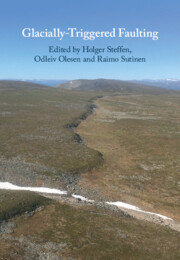Book contents
- Glacially-Triggered Faulting
- Glacially-Triggered Faulting
- Copyright page
- Contents
- Figures
- Tables
- Contributors
- Preface
- Part I Introduction
- Part II Methods and Techniques for Fault Identification and Dating
- 3 Earthquake-Induced Landforms in the Context of Ice-Sheet Loading and Unloading
- 4 The Challenge to Distinguish Soft-Sediment Deformation Structures (SSDS) Formed by Glaciotectonic, Periglacial and Seismic Processes in a Formerly Glaciated Area
- 5 Glacially Induced Fault Identification with LiDAR, Based on Examples from Finland
- 6 Fault Identification from Seismology
- 7 Imaging and Characterization of Glacially Induced Faults Using Applied Geophysics
- 8 Dating of Postglacial Faults in Fennoscandia
- 9 Proposed Drilling into Postglacial Faults
- Part III Glacially Triggered Faulting in the Fennoscandian Shield
- Part IV Glacially Triggered Faulting at the Edge and in the Periphery of the Fennoscandian Shield
- Part V Glacially Triggered Faulting Outside Europe
- Part VI Modelling of Glacially Induced Faults and Stress
- Part VII Outlook
- Index
- References
5 - Glacially Induced Fault Identification with LiDAR, Based on Examples from Finland
from Part II - Methods and Techniques for Fault Identification and Dating
Published online by Cambridge University Press: 02 December 2021
- Glacially-Triggered Faulting
- Glacially-Triggered Faulting
- Copyright page
- Contents
- Figures
- Tables
- Contributors
- Preface
- Part I Introduction
- Part II Methods and Techniques for Fault Identification and Dating
- 3 Earthquake-Induced Landforms in the Context of Ice-Sheet Loading and Unloading
- 4 The Challenge to Distinguish Soft-Sediment Deformation Structures (SSDS) Formed by Glaciotectonic, Periglacial and Seismic Processes in a Formerly Glaciated Area
- 5 Glacially Induced Fault Identification with LiDAR, Based on Examples from Finland
- 6 Fault Identification from Seismology
- 7 Imaging and Characterization of Glacially Induced Faults Using Applied Geophysics
- 8 Dating of Postglacial Faults in Fennoscandia
- 9 Proposed Drilling into Postglacial Faults
- Part III Glacially Triggered Faulting in the Fennoscandian Shield
- Part IV Glacially Triggered Faulting at the Edge and in the Periphery of the Fennoscandian Shield
- Part V Glacially Triggered Faulting Outside Europe
- Part VI Modelling of Glacially Induced Faults and Stress
- Part VII Outlook
- Index
- References
Summary
Using information from airborne light detection and ranging (LiDAR) data has produced a breakthrough in identification of postglacial faults and earthquake-deformed Quaternary deposits. LiDAR digital elevation models (DEMs) also improve the collection of detailed information on their spatial distribution, characteristics and geometry, and provides guidance for the more costly and time-consuming field studies. In areas of weak glacial erosion, younger and older (i.e. Pre-Late Weichselian) ruptures have been discovered superimposed on the same or adjacent postglacial fault segments, as has been identified when combining the DEM information and test pit sedimentological studies. We discuss Finnish examples and identify advantages, disadvantages and limitations. Advantages include verification of previously known fault scarps, detection of new postglacial fault segments, systems and entire complexes and the ability to measure the dimensions (lengths and offset) of the fault scarps from the LiDAR DEM data. Disadvantages include that inventory of the sub- and postglacial fault scarps is only possible when linear scarps cross-cut glacial and postglacial sediments.
Keywords
- Type
- Chapter
- Information
- Glacially-Triggered Faulting , pp. 89 - 99Publisher: Cambridge University PressPrint publication year: 2021



